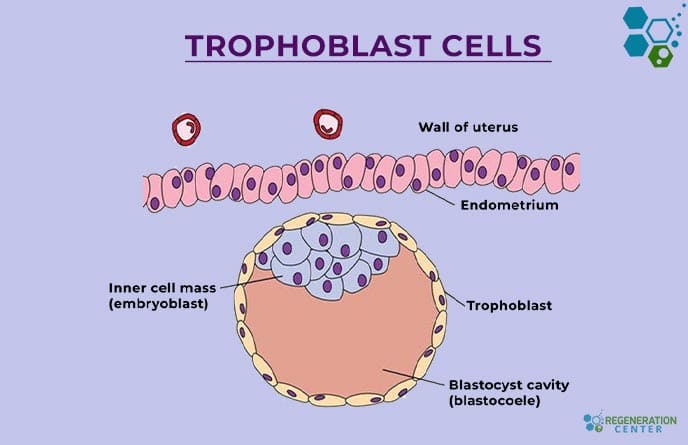
Trophoblasts are the outermost cell layer of a blastocyst primarily responsible for the implantation process [1]. A trophoblast develops into extra-embryonic tissues, and these include the placenta. [2]
Trophoblasts are specialized cells that play a pivotal role in the early stages of mammalian development, particularly in the formation of the placenta. Originating from the outer layer of the blastocyst—the early stage embryo—trophoblast cells have the primary functions of facilitating embryo implantation and interfacing with the maternal endometrium to establish nutrient and waste exchange.
Trophoblasts also functions in controlling oxygen and metabolite exchange that transpires between the embryo and the mother [3]. Trophoblasts are also sometimes referred to as trophoderm. [4]
During early pregnancy, the trophoblast cells undergo differentiation and invasion, which are essential for placenta formation and successful pregnancy outcome. Differentiation includes the transformation from cytotrophoblasts to syncytiotrophoblasts and extravillous trophoblasts, as mentioned above.
[1] ^ Hibaoui, Youssef, and Anis Feki. 2013. Human pluripotent stem cells as alternative models to study trophoblast development. Frontiers in physiology (December 17). doi:10.3389/fphys.2013.00374. https://www.ncbi.nlm.nih.gov/pubmed/24381561
[2] ^ Morales-Prieto, D M, S Ospina-Prieto, A Schmidt, W Chaiwangyen, and U R Markert. 2013. Elsevier Trophoblast Research Award Lecture: origin, evolution and future of placenta miRNAs. Placenta (December 16). doi:10.1016/j.placenta.2013.11.017. https://www.ncbi.nlm.nih.gov/pubmed/24378039
[3] ^ Red-Horse, Kristy, Yan Zhou, Olga Genbacev, Akraporn Prakobphol, Russell Foulk, Michael McMaster, and Susan J Fisher. 2004. Trophoblast differentiation during embryo implantation and formation of the maternal-fetal interface. The Journal of clinical investigation, no. 6. https://www.ncbi.nlm.nih.gov/pubmed/15372095
[4] ^ Taga, Shigeki, Junko Haraga, Mari Sawada, Aya Nagai, Dan Yamamoto, and Ryoji Hayase. 2013. A case of placental mesenchymal dysplasia. Case reports in obstetrics and gynecology (November 20). doi:10.1155/2013/265159. https://www.ncbi.nlm.nih.gov/pubmed/24349807
If you've seen people take ice baths or cold showers and wondered if they're onto… Read More
Immunomodulation stands at the forefront of biomedical research, steering the immune system's ability to fight… Read More
Stem cell research leads the charge in medical innovation, heralding revolutionary advances in regenerative medicine.… Read More
The blood-brain barrier (BBB) is a crucial shield for the brain, regulating the entry of… Read More
While peptide bonds are fundamental to protein structure, their direct relationship with stem cells lies… Read More
When discussing cutting-edge cancer treatments, NK cell therapy stands out due to its unique approach… Read More